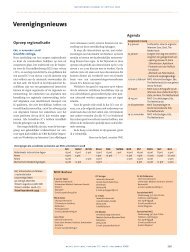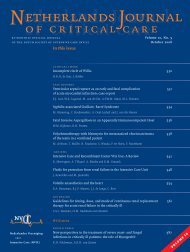Netherlands Journal of Critical Care
Netherlands Journal of Critical Care - NJCC
Netherlands Journal of Critical Care - NJCC
Create successful ePaper yourself
Turn your PDF publications into a flip-book with our unique Google optimized e-Paper software.
<strong>Netherlands</strong> <strong>Journal</strong> <strong>of</strong> <strong>Critical</strong> <strong>Care</strong><br />
give sedation in low dose to improve the quality <strong>of</strong> the SSEP. This is<br />
especially the case in patients with generalized periodic discharges,<br />
which in some situations can be supressed after administration <strong>of</strong><br />
prop<strong>of</strong>ol. These periodic discharges <strong>of</strong>ten have large amplitudes in<br />
comparison to the evoked potential and can disturb the cortical<br />
response. An illustration <strong>of</strong> a positive effect <strong>of</strong> prop<strong>of</strong>ol on the<br />
quality <strong>of</strong> the SSEP recording is given in figure 3.<br />
Discussion<br />
Prognostication <strong>of</strong> comatose patients in the ICU using clinical<br />
examination is <strong>of</strong>ten difficult and neurophysiological assessment<br />
may assist in clinical decision making. The SSEP is a relatively simple,<br />
inexpensive, and non-invasive method to evaluate functional damage<br />
to the complete sensory pathway from the peripheral nervous<br />
system, dorsal column <strong>of</strong> the spinal cord, lemniscal pathways in the<br />
brainstem, with eventual arrival at the somatosensory cortex.<br />
The SSEP can be used in the prediction <strong>of</strong> the neurological outcome<br />
in comatose patients with different aetiologies. However, it is<br />
only sufficiently reliable in predicting poor neurological outcome<br />
in patients with a post-anoxic coma, although the sensitivity for<br />
predicting a poor outcome is relatively low. For the prediction <strong>of</strong> a<br />
favourable neurological outcome the SSEP cannot be used. Other<br />
neurophysiologic tools, such as continuous EEG 13 and the mismatch<br />
negativity and P300 responses 24,25 may provide additional or even<br />
improved information in these cases.<br />
In TBI patients, SSEPs can assist in the prognosis, but should never<br />
be considered in isolation but integrated with other neurophysiologic<br />
tools and clinical examination. In patients with subarachnoid<br />
haemorrhage or sepsis the SSEP has no prognostic value.<br />
Since the SSEP is usually recorded for prognostication, absent<br />
cortical responses almost always lead to withdrawal <strong>of</strong> intensive<br />
care treatment, the clinician interpreting the results <strong>of</strong> the SSEP<br />
recording has to be 100% certain. Decisions to withdraw treatment<br />
are irreversible and therefore the N20 SSEPs should be considered as<br />
‘not bilaterally absent’ in cases <strong>of</strong> doubt.<br />
In conclusion, the SSEP is a very reliable and reproducible method,<br />
if it is performed and interpreted correctly. A bilateral absent N20<br />
response is a reliable predictor for poor neurological outcome in<br />
patients with a postanoxic coma. In postanoxic patients treated with<br />
hypothermia, the SSEP can reliable be measured after rewarming and<br />
probably also during the period <strong>of</strong> hypothermia. In other comatose<br />
patients, such as TBI patients or patients with a subarachnoid<br />
haemorrhage, the SSEP measurement is not reliable enough for the<br />
prognosis <strong>of</strong> poor outcome to use as a single parameter in clinical<br />
decision making. During SSEP measurements great care should be<br />
taken in improving the signal to noise ratio. If the noise level is too<br />
high, the peripheral responses are abnormal, or the response is not<br />
reproducible in a second set <strong>of</strong> stimuli, interpretation <strong>of</strong> the SSEP<br />
cannot be done reliably and the SSEP should be measured again in<br />
a later stage.<br />
References<br />
1. Cruccu G, Amin<strong>of</strong>f MJ, Curio G, et al. Recommendations for the clinical use <strong>of</strong> somatosensory-evoked<br />
potentials. Clin Neurophysiol 2008;119:1705-1719<br />
2. Morgalla MH, Bauer J, Ritz R, Tatagiba M. Coma. The prognostic value <strong>of</strong> evoked potentials<br />
in patients after traumatic brain injury. Anaesthesist 2006;55:760-768 In German.<br />
3. Allison T, McCarthy G, Wood CC, Jones SJ. Potentials evoked in human and monkey<br />
cerebral cortex by stimulation <strong>of</strong> the median nerve a review <strong>of</strong> scalp and intracranial<br />
recordings. Brain 1991;114:2465–503<br />
4. van Putten MJAM. The N20 in post-anoxic coma: Are you listening? Clin Neurophsyiol<br />
2012;123;1460-4<br />
5. Zandbergen EG, de Haan RJ, Stoutenbeek CP, et al. Systematic review <strong>of</strong> early prediction<br />
<strong>of</strong> poor outcome in anoxic-ischaemic coma. Lancet 1998;352:1808-1812<br />
6. Robinson LR, Micklesen PJ, Tirschwell DL, Lew HL. Predictive value <strong>of</strong> somatosensory<br />
evoked potentials for awakening from coma. Crit care med 2003;31:960-967<br />
7. Wijdicks EFM, Hijdra A, Young GB, Bassetti CL Wiebe A. Practice parameter: Prediction<br />
<strong>of</strong> outcome in comatose survivors after cardiopulmonary resuscitation (an evidence-based<br />
review): Report <strong>of</strong> the Quality Standards Subcommittee <strong>of</strong> the American<br />
Academy <strong>of</strong> Neurology. Neurology 2006;67;203-210<br />
8. Rossetti AO, Oddo M, Logroscino G, Kaplan PW. Prognostication after cardiac arrest and<br />
hypothermia: A prospective study. Ann Neurology 2010;67:301-307<br />
9. Bouwes A, Binnenkade JM, Kuiper MA et al. Prognosis <strong>of</strong> coma after therapeutic hypothermia:<br />
A prospective cohort study. Ann Neurology 2012;71:206-212<br />
10. Leithner C, Ploner CJ, Hasper D, Storm. Does hypothermia influence the predictive<br />
value <strong>of</strong> bilateral absent N20 after cardiac arrest? Neurology 2010;74:965-969<br />
Figure 3. Example <strong>of</strong> the effect <strong>of</strong> Esmeron and Prop<strong>of</strong>ol on a SSEP after stimulation <strong>of</strong> the right n. medianus in a patient after resuscitation. The evoked<br />
potential is measured cortical (CP3), cervical (Cerv), at Erb’s point and at the elbow (Elb). Before administration <strong>of</strong> prop<strong>of</strong>ol the EEG showed generalized<br />
periodic discharges, while after the administration <strong>of</strong> prop<strong>of</strong>ol the EEG showed diffuse delta activity<br />
Before administration <strong>of</strong> prop<strong>of</strong>ol<br />
CP3<br />
2.5 µV<br />
After administration <strong>of</strong> prop<strong>of</strong>ol<br />
CP3<br />
2.5 µV<br />
Cerv<br />
10 µV<br />
Cerv<br />
10 µV<br />
Erb<br />
10 µV<br />
Erb<br />
10 µV<br />
Elb<br />
10 µV<br />
Elb<br />
10 µV<br />
10 ms 10 ms<br />
8 Neth j crit care – volume 17 – no 1 – february 2013







